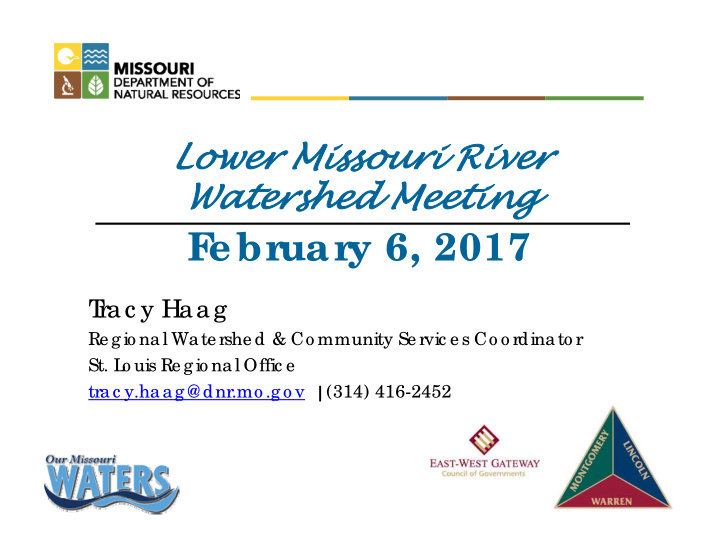



Lower Missouri River Lower Missouri River Watershed Meeting Watershed Meeting F ebr uar y 6, 2017 T rac y Haag Re gio nal Wate rshe d & Co mmunity Se rvic e s Co o rdinato r St. L o uis Re gio nal Offic e trac y.haag@dnr.mo .go v | (314) 416-2452
• Mission: The mission of the Missouri Department of Natural Resources is to protect our air, land and water; preserve our unique natural and historic places; and provide recreational and learning opportunities for everyone. • Vision for Missouri : The Missouri Department of Natural Resources envisions a Missouri where people live and work in harmony with our natural and cultural resources, make decisions that result in a quality environment, and prosper today and in the future .
Our Missour i Water s Pilot Pr ojec t 2012-2016 Goals of the Effort: • Raise Awareness • Receive Input • Build Partnerships • Coordinate Efforts • We are also synchronizing site specific NPDES permits to expire/renew in the same year for permits in the same HUC 8 watershed • Long term goal – maintain and improve water quality and wisely manage water supply
Ho w do we c o llabo rate at the HU C 8 le ve l? • Phased approach – it takes time! • Partnership with the Missouri Association of Council of Governments • Partnership with MU– Extension specialists • Reaching out to agency partners and NGOs – federal, state, local • Transparent process, advertised publicly and open to the public
Lower Missouri
Big Muddy Missouri
Water Quality trends on Missouri’s rivers Stream Location Variable* Trend Probable Cause Spring R. Waco TDS Increase Coal mining, Barton County NO3 Increase Unknown Meramec R. Sullivan SO4 Increase Lead mining, Iron County Elk R. Tiff City SO4 Increase Unknown NO3 Increase Poultry, hog production Missouri R. St. Joseph NO3 Increase Unknown TSS Decrease Soil conservation Mississippi R. Thebes Increase Many urban, rural sources NO3 TSS Decrease Unknown Mississippi R. Alton TSS Decrease Soil conservation *Key - NO3 - nitrate nitrogen, SO4 - sulfate, TDS - total dissolved solids, TSS - total suspended solids
Acronyms and Government Speak Clean Water Law EPA DNR WQ OMW DMR FAC 303d
Water Quality Missouri Water Quality 305(b) Integrated Report .
Water Quality 303d listed streams: • Bonnehomme Creek • Coldwater Creek • Creve Coeur Creek • Fee Fee Creek • Missouri River • Wildhorse Creek
Land use
Agriculture
“discharge of pollutants… …eliminated by 1985”
Point vs NonPoint Sources
How does water pollution occur? Availability Loading Detached Adsorbed Dissolved Transport
Missouri Agriculture and Forestry • For every million dollars generated by agriculture and forestry, there is $420,000 in additional output and 4.4 jobs created in other industries. • In 2016, agriculture, forestry and related industries in Missouri contributed: – $88.4 billion in total sales (including food and related products manufacturing; crop, livestock, forage and fisheries production; agricultural inputs and services; and forest products manufacturing) – $33 billion in value ‐ added activity – $55.4 billion for the purchase of inputs – $17.5 billion in labor income – $4 billion in federal taxes – $2.2 billion in state/local taxes – 378,232 jobs
Cost ‐ Share Practice Categories • Sheet/Rill and Gully Erosion • Grazing Management • Irrigation Management • Nutrient and Pest Management • Sensitive Areas • Woodland Erosion Voluntary conservation practices can save you time and money and increase your farm’s production while protecting the overall natural environment of the state.
Nonpoint source reductions “Nearly 75 percent of farmers have already changed some farming practices to help reduce the delivery of nonpoint source pollutants. “ www.nrcs.usda.gov
Flood of ‘93
Water quality depends on soil quality
Successful Implementation
Protecting watersheds: What You Can Do • Watershed, Lake or River Association • Stream Team • Planting trees • Shore up stream banks • On ‐ site Wastewater improvements • Implement conservation practices
Thank you! Got questions? Call or email! Got questions? Call or email! Tracy Haag Tracy Haag St. Louis Regional Watershed Coordinator St. Louis Regional Watershed Coordinator Missouri Department of Natural Resources Missouri Department of Natural Resources tracy.haag@dnr.mo.gov tracy.haag@dnr.mo.gov (314)416-2452 (314)416-2452
Recommend
More recommend